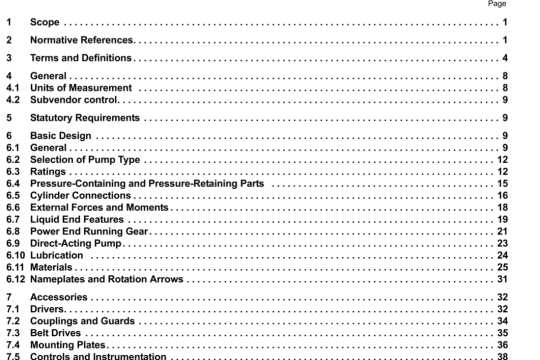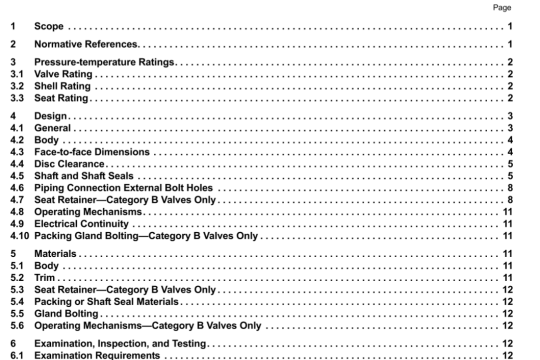API 600:2009 pdf download
API 600:2009 pdf download.Steel Gate Valves-Flanged and Butt-welding Ends, Bolted Bonnets.
5.8.5 Oul of straightness of the entire length of the stem shall not exceed 0.001 inJin. (0.001 maVmm).
5.8.6 The stem end that connects to a gate shall be in the form of a “T,” except that for a doub’e-disc gate, the end connection may be threaded.
5.8.7 The stem connection shall be desagned to prevent the stem from turning or from becoming disengaged from the gate while the valve is in service,
5.8.8 The stem design shall be such that the strength of the stem to gate connection and the pail of the stem within the valve pressure boundary shall, under axial load, exceed the strength of the stem at the root of the operating thread
58.9 The one-piece stem shall incbjde a conical or spherical raised surface that seats against the bonnet backseat when the gate is at its ui open position. A stem-bonnet backseat is a requirement of this International standard and, as such, is not meant to imply a manufacture?s recommendation of its use for the purpose of adding or replacing packing while the valve is under pressure.
5.8.10 The stem nut design shall alow for the removal of the handwtieel while keeping the stem (and disc) in a fixed position.
5.811 The sten,-nut-to-tiandwheel attachment shall be through a hexagonal interlace, a round interface having a keyway or another means of equivalent strength.
5.8.12 When the stern nut is retained in the yoke by means of a threaded bushing, the bushing shall be secured in place using either a lock weld or a positive mechanical lock. Locking by simple metal upsetting such as peening or staking is not permitted
5.10.4 Bolting with diameters 1 in. (25 mm) and smaller shall have coarse (UNC) threads or the most nearty corresponding metric threads. Bolting with diameters larger than I in. (25 mm) shall be 8-thread series (8UN) or the most nearly corresponing metric threads. Bolt threads shall be Class 2A and nut threads shall be Class 28, in accordance with ASME Bit. Studs used for gland bolting shall use a Class 5 interference fit conforming to ASME 81.12. When metric bolting is used metric bolt threads shall be tolerance Class 6g and nuts tolerance Class 6H in accordance with ASME B1.13M.
5.11 Operation
5.11.1 Unless otherwise specified by the purchaser, the valve shel be supplied with a direct operated handwheel that opens the valve when turned in a counter-clockwise direction.
5.11.2 The handwtieel shall be a spoke-nm type with a maximum of six spokes and shall be free from burrs and sharp edges. Unless otherwise specified, the handwheel shall be a one-piece casting or forging or a multi-piece carbon steel fabrication that includes other carbon steel product forms, Fabricated handwheels shall have strength and toughness characteristics comparable to that of handwheels made as one-piece castings or forgings.
5.11.3 The handwheel shall be marked with the word OPEN’ and an arrow pointing in the direction of opening.
except when the handwheel size makes such marking impractical.
5.11.4 The handwheel shall be retained on the stem nut by a threaded hanctwfieel nut.
5.11.5 II operation by a chain wheel, gearbox or power actuator is lo be added to the valve, the purchaser shall specify the following, as applicable:
— for chainwheel operation, the dimension from the centerline of the valve stem to the bottom of the chain loop;
— sp or bevel gear and the position of geanng handwheel relative to the pipe axis:
— electric, hydraulic, pneumatic or other actualor type;
— maximum service temperature and pressure differential across the valve dac;
— power sply attributes for power actuators
5.11.6 Valve-to-gear-box or power actuator flange mating dimensions shall be aocoroing to ISO 5210 or shall comply with the purchasers specifications.
5.12 Bypasses and Other Auxiliary Connections
Auxiliary connections to the body and/or bonnet, such as drains shall be furnished only if specified on the purchase order The design and construction of the joint and the piping of auxiliary connections shall conform to the requirements of ASME 816.34. When required for valve NPS 2 or larger, auxiliary connections shall be sized and located as specilled in ASME Bi 6.34. The size and location of auxiliary connections shall be indicated on the purchase order,
6 Materials
6.1 Materials Other Than Trim Materials
Materials for body, bonnet, and valve parts other than trim items shall be selected from Table 7.




